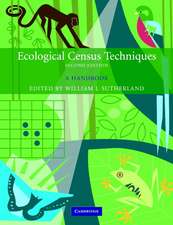Crassulacean Acid Metabolism: Analysis of an Ecological Adaptation: Ecological Studies, cartea 30
Autor M. Kluge, I. P. Tingen Limba Engleză Paperback – 15 noi 2011
Din seria Ecological Studies
- 18%
 Preț: 1118.93 lei
Preț: 1118.93 lei -
 Preț: 553.72 lei
Preț: 553.72 lei - 18%
 Preț: 1680.55 lei
Preț: 1680.55 lei - 18%
 Preț: 1003.38 lei
Preț: 1003.38 lei - 20%
 Preț: 1004.71 lei
Preț: 1004.71 lei -
 Preț: 480.62 lei
Preț: 480.62 lei - 5%
 Preț: 752.26 lei
Preț: 752.26 lei - 15%
 Preț: 643.99 lei
Preț: 643.99 lei - 15%
 Preț: 644.18 lei
Preț: 644.18 lei - 15%
 Preț: 652.49 lei
Preț: 652.49 lei - 18%
 Preț: 789.83 lei
Preț: 789.83 lei -
 Preț: 382.36 lei
Preț: 382.36 lei - 15%
 Preț: 643.48 lei
Preț: 643.48 lei - 15%
 Preț: 646.30 lei
Preț: 646.30 lei - 15%
 Preț: 634.32 lei
Preț: 634.32 lei -
 Preț: 384.86 lei
Preț: 384.86 lei - 18%
 Preț: 789.98 lei
Preț: 789.98 lei - 15%
 Preț: 645.14 lei
Preț: 645.14 lei - 15%
 Preț: 649.39 lei
Preț: 649.39 lei - 18%
 Preț: 1005.43 lei
Preț: 1005.43 lei - 18%
 Preț: 949.23 lei
Preț: 949.23 lei - 15%
 Preț: 649.54 lei
Preț: 649.54 lei - 15%
 Preț: 643.34 lei
Preț: 643.34 lei - 15%
 Preț: 649.71 lei
Preț: 649.71 lei - 15%
 Preț: 638.76 lei
Preț: 638.76 lei - 18%
 Preț: 957.62 lei
Preț: 957.62 lei - 18%
 Preț: 1235.25 lei
Preț: 1235.25 lei - 18%
 Preț: 962.18 lei
Preț: 962.18 lei - 18%
 Preț: 949.23 lei
Preț: 949.23 lei - 15%
 Preț: 660.68 lei
Preț: 660.68 lei -
 Preț: 397.76 lei
Preț: 397.76 lei - 15%
 Preț: 638.24 lei
Preț: 638.24 lei - 18%
 Preț: 942.31 lei
Preț: 942.31 lei - 18%
 Preț: 1232.57 lei
Preț: 1232.57 lei - 15%
 Preț: 651.34 lei
Preț: 651.34 lei - 18%
 Preț: 952.72 lei
Preț: 952.72 lei - 18%
 Preț: 1834.27 lei
Preț: 1834.27 lei - 18%
 Preț: 1229.10 lei
Preț: 1229.10 lei -
 Preț: 423.95 lei
Preț: 423.95 lei - 18%
 Preț: 948.92 lei
Preț: 948.92 lei
Preț: 638.57 lei
Preț vechi: 751.25 lei
-15% Nou
Puncte Express: 958
Preț estimativ în valută:
122.19€ • 133.14$ • 102.96£
122.19€ • 133.14$ • 102.96£
Carte tipărită la comandă
Livrare economică 23 aprilie-07 mai
Preluare comenzi: 021 569.72.76
Specificații
ISBN-13: 9783642670404
ISBN-10: 3642670407
Pagini: 228
Ilustrații: XII, 212 p.
Dimensiuni: 170 x 244 x 12 mm
Greutate: 0.37 kg
Ediția:Softcover reprint of the original 1st ed. 1978
Editura: Springer Berlin, Heidelberg
Colecția Springer
Seria Ecological Studies
Locul publicării:Berlin, Heidelberg, Germany
ISBN-10: 3642670407
Pagini: 228
Ilustrații: XII, 212 p.
Dimensiuni: 170 x 244 x 12 mm
Greutate: 0.37 kg
Ediția:Softcover reprint of the original 1st ed. 1978
Editura: Springer Berlin, Heidelberg
Colecția Springer
Seria Ecological Studies
Locul publicării:Berlin, Heidelberg, Germany
Public țintă
ResearchCuprins
Terminology.- 1. Taxonomy and Geographical Distribution of CAM Plants.- 1.1 Cactaceae.- 1.2 Crassulaceae.- 1.3 Euphorbiaceae.- 1.4 Aizoaceae (Mesembryanthemaceae).- 1.5 Bromeliaceae.- 1.6 Asclepiadaceae.- 1.7 Orchidaceae.- 1.8 Liliaceae.- 1.9 Agavaceae.- 1.10 Asteraceae.- 1.11 Vitaceae.- 1.12 Geraniaceae.- 1.13 Other Families.- 1.14 Conclusions.- 2. Morphology, Anatomy, and Ultrastructure of CAM Plants.- 2.1 What is a Succulent?.- 2.2 Quantitative Indices of Succulence.- 2.3 Succulence and the Occurrence of CAM.- 2.4 The Presence of the Photosynthetic Apparatus as a Prior Condition for the Occurrence of CAM.- 2.5 The Architecture and Ultrastructure of CAM-Performing Cells.- 3. The Metabolic Pathway of CAM.- 3.1 The Processes of the Dark Period.- 3.2 The Processes of the Light Period.- 3.3 Carbon Isotope Composition.- 3.4 The Proposed Total Carbon Flow in CAM.- 3.5 Comparison of CAM with Other Carboxylation Pathways in Plants.- 3.6 Translocation of CAM Products in the Plant.- 4. Control and Modification of CAM.- 4.1 Definitions.- 4.2 Metabolic Control of CAM.- 4.3 Modification of the Diurnal Malic Acid Cycle by External Factors.- 4.4 Seasonal Control of CAM.- 4.5 Developmental Control of CAM.- 4.6 Conclusions.- 5. Gas Exchange of CAM Plants.- 5.1 CO2 Exchange.- 5.2 Oxygen Exchange.- 5.3 Water Vapor Exchange and Stomata of CAM Plants.- 6. Ecology, Productivity, and Economic Use of CAM Plants.- 6.1 The Hypothesis: Ecological Advantage of CAM.- 6.2 Verification of the Hypothesis.- 6.3 Productivity.- 6.4 Economic Exploitation.- References.- Taxonomic Index.













